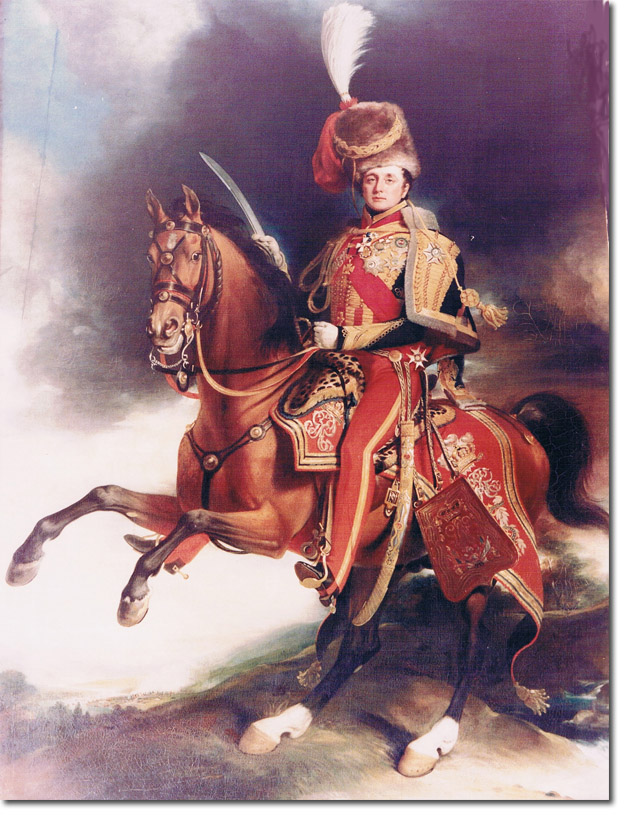|
|


|
|
Charles William Stewart was born in Dublin on 18 May 1778. He was the son of Robert Stewart who was later (1789) created Baron Londonderry in the Peerage of Ireland. Charles’s mother was his father’s second wife, Frances Pratt, daughter of the Earl of Camden. His half brother was Viscount Castlereagh. Charles entered the army on 3 April 1791 at the age of 12. He was an ensign in the 108th regiment, rising to lieutenant in Jan 1793. He saw service in Flanders in 1794, and in the Irish Rebellion of 1798. Later he was a lieutenant-colonel in the 5th Royal Irish Dragoons which was disbanded around that time. He served in the Hussar Brigade in 1808 which fought in Spain.
When the Peninsula War resumed he was appointed Adjutant-General to Sir Arthur Wellesley, and fought at Talavera, Bussaco, and Fuentes de Oñoro. In the last battle he captured a French colonel after single combat. Wellesley sacked him in 1812 for mischief-making among the staff. On 20 Nov 1813 he was appointed Colonel of the 25th Light Dragoons and later in the year he was appointed Knight of the Bath (GCB). He was made Knight Grand Cross of the Guelphic Order (GCH) in 1816 and appointed Colonel of the 10th Royal Hussars on 3 Feb 1820. On 23 June 1843 he was appointed Colonel of the 2nd Life Guards. Charles Stewart was an MP in the Irish House of Commons from 1796 to 1801, and then represented Londonderry in the British House of Commons until 1814. He was Under-Secretary for War and the Colonies from 1807. He was a plenipotentiary in Berlin and later in Austria where he was ambassador for 9 years. He was married twice. His first wife was Lady Catherine Bligh who gave birth to their son Frederick the inheritor of the title, but she died in 1812. His second wife was Lady Frances Anne Vane-Tempest, who stood to inherit an immense fortune on the condition that Charles changed his name to Vane. The money enabled him to build Wynyard Park, but it was gutted by fire and had to be rebuilt. He also redecorated the Irish country house, Mount Stewart, and purchase Londonderry House in Park Lane. He was a controversial landlord in Ireland during the 1840s Famine. He was said to have treated his tenants unsympathetically. His character seems to have been severely flawed. Apart from the mischief-making on Wellesley’s staff in Spain, he behaved very undiplomatically during his time in Vienna as British Ambassador. He was often drunk, visited prostitutes and picked a fight with a coachman in the street. But it has to said that he also enjoyed more honourable pursuits. He was a prolific writer of history, and his own exploits in the army and the diplomatic service. Charles William Vane, the Most Honourable The Lord Londonderry, as he was styled at the end of his life, died on 6 March 1854. There is a well-known equestrian statue of the Marquess in Durham, wearing the uniform of a General officer of Hussars. He was Lord Lieutenant of Durham in 1842 and his widow commissioned the sculptor Raffaelle Minti in 1858 to model the edifice in his honour. There is another monument to his memory, fittingly it is a folly, Scrabo Tower at Newtownards in co Down, Northern Ireland, built by his son Frederick, 4th Marquess of Londonderry. The portrait, from Wynyard Park shows the Marquess in the uniform of a General Officer of Hussars based on the 10th Hussars uniform. |
Armed Forces | Art and Culture | Articles | Biographies | Colonies | Discussion | Glossary | Home | Library | Links | Map Room | Sources and Media | Science and Technology | Search | Student Zone | Timelines | TV & Film | Wargames